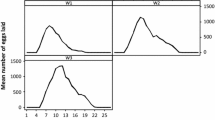Abstract
The duration of the life cycle of O. tholozani is related to the presence of hosts; it can last between 7 and 12 months if hosts are abundant. However, tick stages (third stage nymphs and adults) can live for 10 years in starvation when there is irregular host availability. Long-term survival of O. tholozani individuals up to 20 years was reported under laboratory conditions. All stages of O. tholozani feed and blood sucking lasts 20–30 min. Normally, females feed, mate and oviposit several times in their life; each egg batch includes 100–229 eggs. However, some females may show autogenous oviposition (oviposition without a blood meal in the adult stage); this behaviour was related to a larger female size at ecdysis, but the number of eggs is smaller in autogenous batches compared to regular batches.
Similar content being viewed by others
References
Assous MV, Wilamowski A (2009) Relapsing fever borreliosis in Eurasia-forgotten, but certainly not gone! Clin Microbiol Infect 15:407–414
Assous MV, Wilamowski A, Bercovier H, Marva E (2006) Molecular characterization of tickborne relapsing fever Borrelia. Israel Emerg Infect Dis 12:1740–1743
Avivi A, Warburg M, Galun R (1973) Ecological studies on the cave tick Ornithodoros tholozani and its distribution in Israel. Israel J Entomolog 3:109–1929
Burgdorfer WM, Varma GR (1966) Trans-stadial and transovarial development of disease agents in arthropods. Annu Rev Entomol 12:347–376
Feldman-Muhsam B, Havivi Y (1973) Autogeny in the tick Ornithodoros tholozani (Ixodoidea, Argasidae). J Med Ent 10:185–189
Gray JS, Estrada-Peña AG, Vial LA (2013) Ecology of nidicolous ticks. In: Sonenshine DE, Roe RK (eds) The biology of ticks, vol 2, Oxford University Press, Oxford, pp 39–60
Holbrook MR (2012) Kyasanur forest disease. Antiviral Res 96:353–362
Mahdi M, Erickson BR, Comer JA, Nichol ST, Rollin PE, AlMazroa MA et al. (2011) Kyasanur forest disease virus alkhurma subtype in ticks, Najran Province, Saudi Arabia. Emerg Infect Dis 17:945–947
Pavlovskiy N, Skrynnik AN (1959) Contribution to the biology of the tick Ornithodoros papillipes 3:1403–1405
Řeháčk J (1989) Ecological relationships between ticks and Rickettsia. Eur J Epidemiol 5:407–413
Safdie G, Farrah IY, Yahia R, Marva E, Wilamowski A, Sawalha SS et al (2010) Molecular characterization of Borrelia persica, the agent of tick borne relapsing fever in Israel and the Palestinian Authority. PLoS ONE 5:1–11
Sonenshine DE, Clifford CM, Kohls GM (1966) The systematics of the subfamily Ornithodorinae (Acarina: Argasidae). III. Identification of the larvae of the eastern hemisphere. Ann Entomol Soc Am 59:92–121
Turell MJ, Whitehouse CA, Butler A, Baldwin C, Hottel H, Mores CN (2008) Assay for and replication of karshi (Mammalian Tick-Borne Flavivirus Group) virus in mice. Am J Trop Med Hyg 78:344–347
Vial L (2009) Biological and ecological characteristics of soft ticks (Ixodida: Argasidae) and their impact for predicting tick and associated disease distribution. Parasite 16:191–202
Author information
Authors and Affiliations
Corresponding author
Editor information
Editors and Affiliations
Rights and permissions
Copyright information
© 2017 Springer International Publishing AG, part of Springer Nature
About this chapter
Cite this chapter
Kleinerman, G., Baneth, G. (2017). Ornithodoros (Pavlovskyella) tholozani (Laboulbène and Mégnin, 1882) (Figs. 21 and 22). In: Estrada-Peña, A., Mihalca, A., Petney, T. (eds) Ticks of Europe and North Africa. Springer, Cham. https://doi.org/10.1007/978-3-319-63760-0_16
Download citation
DOI: https://doi.org/10.1007/978-3-319-63760-0_16
Published:
Publisher Name: Springer, Cham
Print ISBN: 978-3-319-63759-4
Online ISBN: 978-3-319-63760-0
eBook Packages: Biomedical and Life SciencesBiomedical and Life Sciences (R0)




